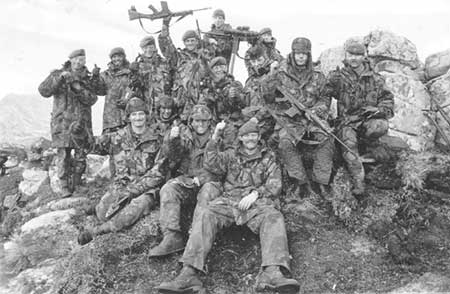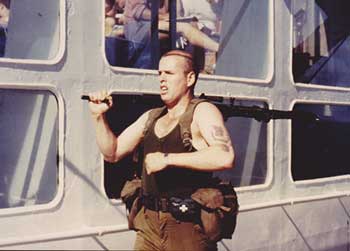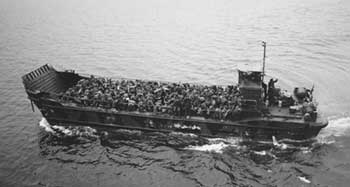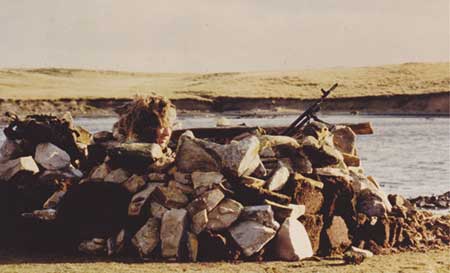Home | About Us | Subscribe | Advertise | Other Publications | Diary | Offers | Gallery | More Features | Obituaries | Contact |
|
|
|
|||||||||||
Asking a soldier to reflect on the forty years since the Falklands conflict is, in terms of time, rather like asking a Boer War veteran his memories by someone approaching the darkest days of World War 2. Nevertheless, there are consistent threads and, from time to time, occasional revelations, coupled, of course, with that not-always-so-helpful factor, hindsight, together with one or two little unsolved mysteries. So that readers are not condemned to endure, purely, the musings of a geriatric arm-chair general, I have sought views from a Guardsman, a Platoon Commander, a Platoon Sergeant and a Company Commander. I also took the precaution of having the text subjected to a ‘red ink correction’ by a former Director General of the Defence Academy 1. I am very grateful to them all for providing the rope to pull me ashore.
I have often found it curious that the Falklands, over the years, retained its interest when so much has happened, in military terms, since. Part of the reason, I think, is that it was a very easy war to understand, whether you were a civilian or professional soldier. A Fascist dictator invaded a British overseas territory, whose inhabitants strongly objected. Unlike the Balkans, Iraq and Afghanistan, there was no political difficulty with the United Kingdom’s response. The population was 100% behind its Government (well, 99.9% if you count Tam Dalyell and Jeremy Corbyn2 as the opposition). There were the Bad Guys – the Argentines – and the Good Guys – us. It was the classic St Augustine Just War, ‘It is the injustice of the opposing side that lays on the wise man the necessity of waging just wars.’ ‘Nae probs’, as my Guardsmen put it.
Weaponry was simple; no magic missiles, no clever cyber intelligence, no brilliant Apache attack helicopters, no drones, no Sat Nav or Wifi but, also, no hot food/medical care/ammunition/dry clothing brought up by the Colour Sergeant at last light. In fact, there weren’t any vehicles to speak of; we had one Land Rover underslung by helicopter into our position, purely to charge our radio batteries. My father, who had skedaddled out of France in May 1940 through Caen, then returned in 1944 to fight from Le Havre to Hamburg, understood it entirely. The oddity was why us? It was not difficult to understand selection of the three highly trained Commandos, under command their own Brigade Headquarters, and two Parachute Battalions; together, arguably, the best shock troops in the world. But 5 Infantry Brigade? It had been recently put together and now a Gurkha battalion, unemployable in Northern Ireland or Germany, and two Foot Guards battalions undergoing Public Duties were put under command. However, it is easy to forget that there seemed, anyway to me, little enthusiasm then from most of the infantry; they were returning from/going to Northern Ireland or BAOR or in baulk to NATO commitments. Anyway, the Royal Navy was going to frighten the pants off the Argentines just as a solitary nuclear submarine had in Callaghan’s day, weren’t they? If not, and it came to land warfare, then who more terrifying than the lethal Commandos and Paras? Clearly, they were going to win the war, then there would be a requirement for a six-month tour residual garrison; not favourite after everyone else had covered themselves with glory. Who better than the Foot Guards? Paint everything Blue-Red-Blue and do double sentry outside Government House. However, due to the uncertainty as to what our role would actually be, I was determined that the Battalion should focus on the most testing case: warfighting. As a result, we maximised our motivation, prepared and trained as if our lives depended on it - which, of course, they did. For us also, it was an easy choice; anything to avoid the Major General’s Inspection. What I didn’t know until years later from a chum working at the time in ‘intelligence’ was that Galtieri was much more worried about the Chileans coming in through his back door than the British. He’d deployed VI and VIII Mountain Brigades on the Andes and XI Brigade, which was cold weather trained, in the extreme south, all facing Chile. No wonder Margaret Thatcher made such a fuss of General Pinochet.
Only relatively recently have I become aware of the ad-hoc command and control of the operation. With the campaign to retake the Islands being mainly a maritime led one, the detailed prosecution of the war was in the hands of the Naval Headquarters at Northwood. (A Permanent Joint Headquarters was not established until 1996). In a separate underground bunker, was a second Headquarters, which had no wartime role. It was an asset provider bringing ships into service, supervising training and the peacetime management of the Fleet. Not only did this Headquarters not have an operational role but it was not staffed to run operations and, in particular, had no understanding of the imperatives of amphibious operations. An early Army visitor noticed that all their maps had contours in the sea (fathoms?) – not surprising, but if the Navy wished to run the entire war on its own, as it clearly did, some attention to the ground over which the men whom they would land on the islands might be relevant. On the Fleet map the land was shown as a contourless nameless blank. However, it was subsequently gripped by an Army element and became much better.
The major constituent over the forty years is the enduring comradeship that exists across all ranks of those who fought in the battle. The shrinks will have a good word for it but more difficult to explain by us soldier boys. A 19 year-old platoon commander in Left Flank, James Stuart4, ‘The platoon I inherited was of a generation and attitude that meant that a majority of them had personal experience of violence and hardship. They were tough and resilient but, being Guards, had a strong sense of loyalty and respect to the Regiment, the Guards and the Crown and Country (in that order!). What we did have was a total belief in the system. We knew each other quite well by the time we got to Tumbledown and we knew that each part of the chain would strive to do the right thing for each other. So, what we trusted was we all would do our best’. The Company Commander Right Flank, Simon Price5, ‘I also had complete confidence in our ‘Guards System’. Providing we did not over complicate our orders I felt certain all ranks would excel and succeed. We were a strong team with confidence in each other and this proved to be correct’. And an 18-year-old Guardsman, Mark Cape6 in Left Flank, ‘No matter how much you train for war, there was nothing that prepared you for the feelings/thoughts faced whilst in the prone position on the line of departure, waiting for the command to advance towards a well dug in and motivated enemy. It was leadership, drive, and sheer grit that secured victory. The question was never who would be victorious, it was how long, would we, the Scots Guards take to root out the enemy on Mount Tumbledown’. Again the Company Commander, ‘Right Flank was counter attacked just after dawn but I had already gone around my whole company and placed my machine guns so I had a co-ordinated defensive position (albeit ad hoc). Attacking the mountain in daylight, as we had previously concluded in our Battalion Command Group appreciation, was not a sensible act of war so I cannot say I was surprised when the enemy only made 15 or so yards before deciding that attacking up a steep rocky mountain against co-ordinated machine guns supported by riflemen was foolhardy in the extreme. Withdrawal/retreat was their only option’.
50% of the casualties (8 killed and 40 wounded) were officers, warrant and non-commissioned officers – leadership from the front. There is an old saying that you fight better among your friends. This was abundantly clear on Tumbledown where trust and confidence up and down and across the ranks was vital. This was further enhanced by our six weeks left behind after the war. While it was an incredibly frustrating and morale lowering time what it did was bolster our ‘decompression’. We lived together, drank together, joked together and swapped stories. There was no outside interference; no family, no Press, no men in white coats asking what was it like to kill people. Company Commander Right Flank, ‘My Company and I had had a different experience from most because after Tumbledown we had been selected to run a POW Camp at the refrigeration plant at Ajax Bay for 525 ‘Special Category7’ prisoners. We spent our time mainly honouring our killed in action by creating as smart a cemetery as we could manage. We also helped the RN build a memorial cross on the hill top half way between HMS Ardent (our affiliated ship) and HMS Antelope that had been sunk in San Carlos Water. These activities, although trying at the time, enabled all Right Flankers to properly wind down which prevented any PTSD cases evolving’.
We were family and it undoubtedly helped to reduce Post Traumatic Stress Disorder. For me, personally, it was a very bad time; I was the only person who could tell the Guardsmen when they were going home and I failed. All my superiors had left and I had to communicate directly with the MoD from my little radio shack in Port Howard. The Queens Own Highlanders, who ultimately relieved us, were dying to come. Why didn’t they earlier? We were there for six weeks. One of the unsolved mysteries. 1 Lieutenant General Sir John Kiszely KCB MC, Company Commander Left Flank. 2 In a rousing address to Hornsey Council, ‘The whole thing is a Tory plot to keep their money-making friends in business’. 3 There was a scathing Channel 4 documentary Falklands War: The Untold Story on 27th March 2022. 4 Later Co-founder and Director PAVOCAT Ltd - Counter-corruption and the Laws of Conflict. 5 He subsequently lectured extensively to battalions (Officers; WOs & NCOs and All Ranks), the Junior Officers Tactics Course and other organisations on The Realities of War and The Battle of Tumbledown. 6 Later a Major and, together with Brigadier Charles Page MBE (a platoon commander in G Company), were the last Scots Guardsmen, who fought in the Falklands, to leave the Army. 7 They weren’t ‘Special Category’ in any sense; merely temporary hostages in case Argentina started again. 8 Later Academy Sergeant Major at Sandhurst and a Lieutenant Colonel with an MBE. |
|||||||||||
|
|||||||||||

 Crags of Tumbledown Mountain
Crags of Tumbledown Mountain
 G Company after the battle
G Company after the battle Guardsman Pengelly training on QE2. Later awarded Military Medal
Guardsman Pengelly training on QE2. Later awarded Military Medal Crammed landing craft (LCU)
Crammed landing craft (LCU)
 Under fire in Assembly Area
Under fire in Assembly Area.jpg)